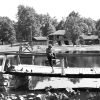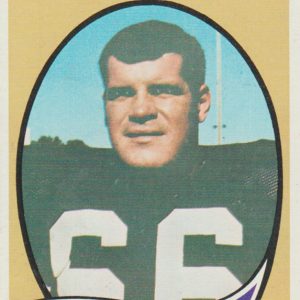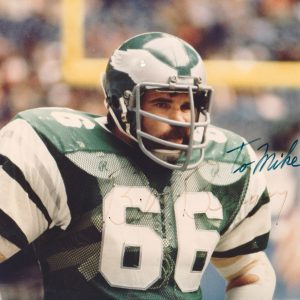calsfoundation@cals.org
William Earl (Bill) Bergey (1945–2024)
Bill Bergey, who was a top-rated football player at Arkansas State University (ASU), was considered by many to be the most outstanding player ever produced by the school since the first team was fielded in 1911. In 1976, fans voted him the top player in Arkansas State history. He established himself as one of the premier defensive players, both during his college days and during his twelve-year career with two National Football League (NFL) teams: the Cincinnati Bengals and Philadelphia Eagles.
William Earl Bergey was born on February 9, 1945, in South Dayton, New York. He was one of forty-seven students to graduate from western New York’s Pine Valley Central School in 1964. He participated in both basketball and football and was a Class B Basketball League All-Star, playing on a team that posted a 19–1 record. He did not begin to play football until he was in the ninth grade. During his high school career, he played both fullback and linebacker. By mid-season of his senior season, he had scored seven touchdowns and seemed to be headed for a stellar year. But in the fourth game, he became ill and did not return to the field until the last game of the season.
After high school, it appeared that Bergey’s football playing days were over. He asked his high school guidance counselor to write and send a letter to approximately ten colleges to see if there was any interest in him playing for them. Only two colleges responded: the University of New Mexico and Arkansas State College (now ASU) in Jonesboro (Craighead County). Bergey pulled out a map to determine where they were and quickly chose to pursue the nearest school. While attending a convention in New York City, Arkansas State coaches asked Bergey if he could meet them there. He gathered up a couple of scrapbooks chronicling his career and headed to the meeting. After his visit, he was offered a partial scholarship.
The 6’3″ Bergey “redshirted” his freshman year (meaning that he delayed full participation to lengthen his period of eligibility), and during the next two seasons he played offensive tackle and defensive nose guard. It was not until his junior year that he was moved to linebacker. From that moment, Bergey said that things began to “click.” By the time he graduated in 1969, he had set five school records: best tackle average in a season; most fumble recoveries in a season; and most tackles in a game, season, and career. During his senior season, he averaged almost twenty tackles a game, making thirty-three tackles against Eastern Michigan. He was selected to the All Southland Conference team three times and All America his senior year. He played in three post-season college all-star games and was named the Outstanding Defensive Player for the South team in the North South Shrine Game. Arkansas State posted a 24–13–1 record during Bergey’s career and made two consecutive appearances in the Pecan Bowl. He was the game’s Outstanding Defensive Player his senior year.
Bergey was drafted in the second round of the National Football League draft in 1969, the thirty-first player chosen. Bergey started at linebacker for the Bengals for five years and was named NFL Defensive Rookie of the Year and selected to participate in the Pro Bowl.
In 1974, Bergey was being courted by the Virginia Ambassadors of the newly formed World Football League (WFL). He was under contract with the Bengals until May 1975 for a salary of $38,750 per year. The Ambassadors were willing to offer Bergey a three-year, no-cut contract at $125,000 per year and a signing bonus of $150,000, of which $42,000 was to be paid at the signing of a contract. The Bengals counteroffered with a new five-year contract that would be worth about $400,000 plus benefits. Bergey turned them down, stating that he had already agreed to join the WFL on a handshake and would not back out.
The Bengals filed an injunction against Bergey and the WFL. However, the court ruled that Bergey had not breached his contract and voided the injunction. Unfortunately, by the time that Bergey was to join the Ambassadors, the team had moved to Florida under the name of the Blazers and had folded. His career was at a standstill until the Bengals traded him to the Philadelphia Eagles for two first-round draft picks and one second-round draft pick.
During his seven seasons at Philadelphia, Bergey played an integral role in the rise of the Eagles. He was named to the All-NFL team from 1974 through 1978 and participated in the Pro Bowl in 1974, 1976, 1977, and 1978. In 1974, he set a (later surpassed) NFL season interception record for a linebacker at five. He was selected as the Eagles MVP three times. In 1976, when he signed a four-year contract worth one million dollars, he became the highest-paid defensive player in professional football. Bergey’s 1979 season was cut short with a serious knee injury in game three. After major rehabilitation, Bergey returned for the 1980 season and ended his career in a losing effort in his only appearance in a Super Bowl, Super Bowl XV.
Bergey received numerous post-career honors. Among these were the Philadelphia Eagles’ Honor Roll, Chautauqua Sports Hall of Fame, Greater Buffalo Sports Hall of Fame, Philadelphia Sports Hall of Fame, and the Professional Football Researchers Association’s Hall of Very Good. In Arkansas, he was inducted into the Arkansas Sports Hall of Fame and the Arkansas State University Hall of Heroes, a hall honoring members of the Reserve Officers’ Training Corps (ROTC), in which Bergey had been a second lieutenant. His jersey was retired by ASU, and in 1976 fans voted him the best player in ASU history. He was also added to the football Ring of Honor on display in ASU’s Centennial Bank Stadium.
After retiring in 1981, Bergey became involved in the hospitality business as part owner in a few hotels and golf courses and made regular public appearances. He also spent over twenty-three years in television and radio as an Eagles post-game commentator. After retirement, he continued to live in the Philadelphia area with his wife, Micky Kay Davenport, whom he met in college and married in the early 1970s. The couple had three sons, two of whom played professional lacrosse.
Bergey died on December 25, 2024, of cancer.
For additional information:
“Bill Bergey.” Pro Football Reference. https://www.pro-football-reference.com/players/B/BergBi00.htm (accessed May 19, 2022).
“Bill Bergey, A-State’s Greatest Player, Admits He Suffered In Jonesboro.” Best of Arkansas Sports. http://www.bestofarkansassports.com/bill-bergey-a-states-greatest-player-admits-he-suffered-in-jonesboro/ (accessed May 19, 2022).
Cohen, Robert W. The 50 Greatest Players in Philadelphia Eagles History. Lanham, MD: Lyons Press, 2019.
Gelston, Dan (Associated Press). “Bergey, a Pro Bowl LB from ASU, Dies at 79.” Arkansas Democrat-Gazette, December 26, 2024, p. 2C. Online at https://www.arkansasonline.com/news/2024/dec/26/bergey-a-pro-bowl-lb-from-asu-dies-at-79/ (accessed December 26, 2024).
Lyon, Bill. “A Farm Boy From Arkansas State Paints The NFL Black and Blue.” Arkansas Times, September 1979, pp. 36–42.
“Where Are They Now: Bill Bergey.” National Football Post. https://nationalfootballpost.com/where-are-they-now-bill-bergey/ (accessed May 19, 2022).
Michael D. Polston
CALS Encyclopedia of Arkansas








Comments
No comments on this entry yet.